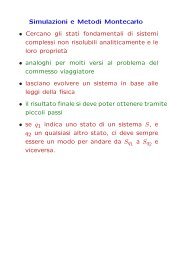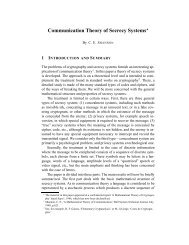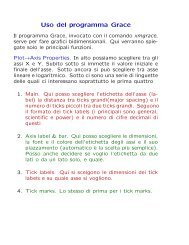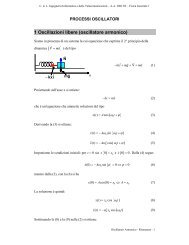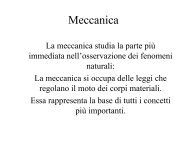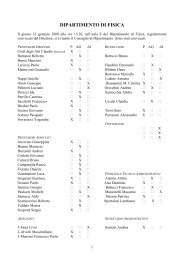PDF (119 KB) - Fisica
PDF (119 KB) - Fisica
PDF (119 KB) - Fisica
You also want an ePaper? Increase the reach of your titles
YUMPU automatically turns print PDFs into web optimized ePapers that Google loves.
624 S. Corezzi et al. / Chemical Physics 323 (2006) 622–624<br />
well-known that relaxation times measured by different<br />
techniques all sensitive to structural dynamics may even<br />
differ by a few decades, which obviously reflects in different<br />
values of s0. It is also well-known that at some intermediate<br />
temperature on heating above Tg, the relaxation mechanism<br />
becomes different from cooperative transitions governed<br />
by the configurational entropy, and a marked<br />
change in the dynamics is observed [13]. Because of this<br />
change the relaxation time of a liquid at high temperature,<br />
which actually corresponds to the phonon time scale, may<br />
differ from s0 in Eq. (2), which is the value extrapolated<br />
from the cooperative regime. The difference between the<br />
two could be less pronounced if the process under analysis<br />
is a simple physical process. However, if it is a chemical<br />
process like polymerization then chemical step activation<br />
entropies could become involved and then all bets should<br />
be off about the value of the pre-exponent s 0.<br />
(3) In [1], the author reports as a feature of Eq. (1) that<br />
‘‘... CP, c of a polymerizing melt at a fixed T would not<br />
change as a increases from zero to one’’, and similarly,<br />
‘‘... the product bcVc, [where bc and Vc are the configurational<br />
contribution to the thermal expansion coefficient<br />
and the volume of the melt] would not change’’. On the contrary,<br />
we note that Eq. (1) yields a factor in C P, c and b c V c<br />
explicitly dependent on a [e.g., C P, c(a) =T(oS c(0)/oT) P<br />
(1 a/a0) =CP, c(0)(1 a/a0)], which factor has been erroneously<br />
omitted in [1]. Therefore, our Sc(a) relation does<br />
not conflict with the observation that changes in CP, b,<br />
and V during a meltÕs polymerization are also to be ascribed<br />
to changes in the configurational contribution to<br />
these quantities.<br />
(4) In our opinion, the calculations of S c performed by<br />
Wang and Johari [15] in a lattice–hole model are interesting<br />
but cannot prevail over the indications coming from experiments,<br />
as we have described. In addition, we observe that<br />
Sc, calculated with plausible values of the adjustable<br />
parameters, in the Wang and JohariÕs model would be<br />
expected to initially increase and then decrease with a in<br />
such a way that the value at the full extent of polymerization<br />
is nearly the same as (or even higher than) in the<br />
monomeric liquid (see Fig. 2 in [15]). This result can hardly<br />
be reconciled with an entropy-based picture of the process<br />
of polymerization; which picture, instead, Johari upholds.<br />
On the other hand, different lattice models exist and provide<br />
different results for the statistics of polymer chains.<br />
Interestingly, in a Flory–Huggins model of equilibrium<br />
polymerization [16] the average length of polymer chains<br />
scales inversely with the excess entropy of the polymer<br />
solution, similarly to our premise Sc / 1/xn.<br />
In conclusion, we believe there are sufficient experimental<br />
indications that Eq. (2) captures the principal physics<br />
behind the dynamical slowdown that occurs in a wide class<br />
of polymerizations, and therefore, goes beyond a mere phenomenological<br />
description of the process. We stress once<br />
more that it is appropriate in a limited range of a and T<br />
but this range usually covers the most part of relaxation<br />
data from experiments.<br />
Acknowledgement<br />
S.C. acknowledges financial support from MIUR-<br />
FIRB.<br />
References<br />
[1] G.P. Johari, Chem. Phys. 305 (2004) 231.<br />
[2] S. Corezzi, D. Fioretto, P. Rolla, Nature 420 (2002) 653.<br />
[3] G. Adam, J.H. Gibbs, J. Chem. Phys. 43 (1965) 139.<br />
[4] xn represents the average number of monomers per molecule in the<br />
system. a, also called the chemical conversion, provides a measure of<br />
the extent of reaction.<br />
[5] High temperature also tends: (i) to favor cyclization, which changes<br />
the variation of xn with a (e.g., xn would grow less rapidly and tend to<br />
diverge at a > a 0), and (ii) to favor departure from the quasiequilibrium<br />
condition.<br />
[6] S. Corezzi, L. Comez, D. Fioretto, J. Non-Cryst. Solids 345–346<br />
(2004) 537.<br />
[7] S. Corezzi, AIP Conf. Proc. 708 (2004) 604.<br />
[8] S. Corezzi, D. Fioretto, J.M. Kenny, Phys. Rev. Lett. 94 (2005)<br />
065702.<br />
[9] For all the polymerizations studied, the temperature was near the<br />
onset of the exothermic release in a calorimetric scan at the heating<br />
rate of 10 °C/min.<br />
[10] G.P. Johari, C. Ferrari, G. Salvetti, E. Tombari, Phys. Chem. Chem.<br />
Phys. 1 (1999) 2997.<br />
[11] E. Tombari, C. Ferrari, G. Salvetti, G.P. Johari, J. Phys. Condens.<br />
Matter 9 (1997) 7017.<br />
[12] C. Ferrari, E. Tombari, G. Salvetti, G.P. Johari, J. Chem. Phys. 110<br />
(1999) 10599.<br />
[13] F. Stickel, E.W. Fischer, R. Richert, J. Chem. Phys. 104 (1996) 2043.<br />
[14] R. Richert, C.A. Angell, J. Chem. Phys. 108 (1998) 9016.<br />
[15] J. Wang, G.P. Johari, J. Chem. Phys. 116 (2002) 2310.<br />
[16] J. Dudowicz, K.F. Freed, J.F. Douglas, J. Chem. Phys. 111 (1999)<br />
7116.



